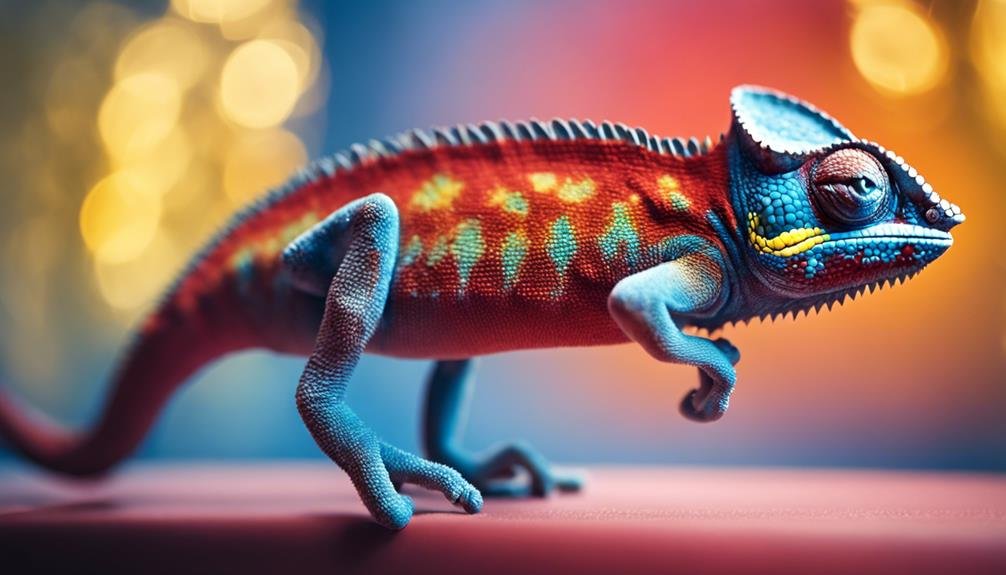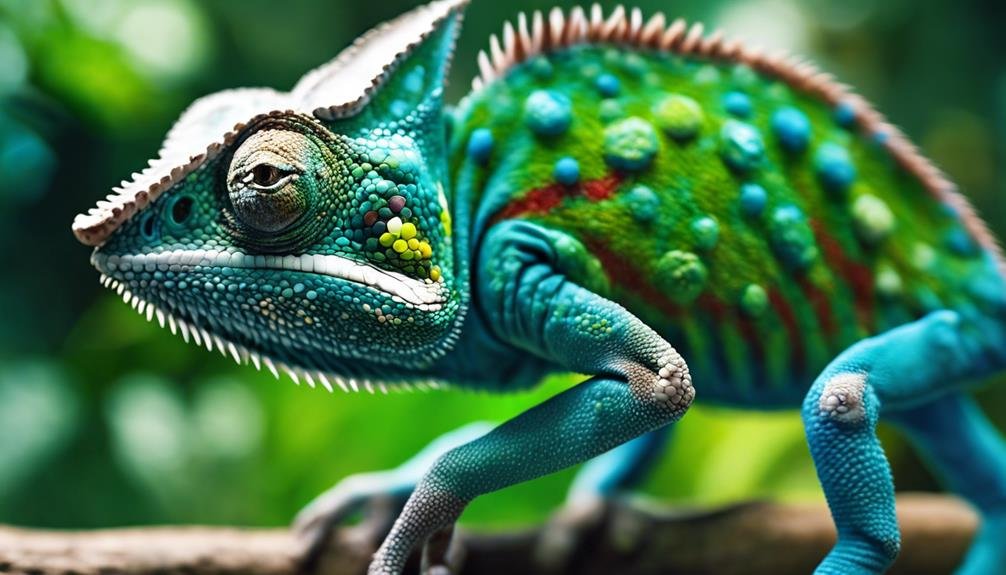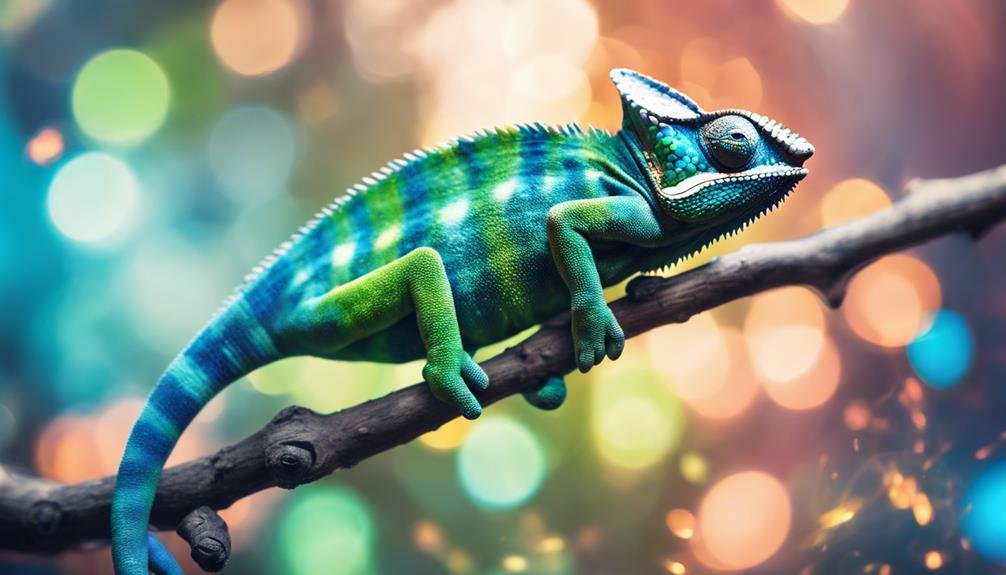You've probably marveled at how chameleons can seamlessly blend into their surroundings or flash vibrant colors during social interactions. This remarkable ability stems from the sophisticated interplay of specialized skin cells known as chromatophores, alongside layers of nanocrystals called iridophores that reflect and refract light. But did you know that factors like mood, temperature, and even social cues can trigger these color transformations? As you explore the intricate mechanisms behind this phenomenon, you'll uncover the complexities of chameleon biology and the evolutionary advantages these color changes confer. Let's peel back the layers to reveal the true spectrum of reasons behind their ever-changing hues.
Key Takeaways
- Chameleons change color through the expansion and contraction of chromatophores containing pigments like melanin, blue, yellow, and red.
- Light reflection and refraction off nanocrystal layers and iridophores produce a spectrum of colors by interacting with pigments.
- Hormones and the autonomic nervous system regulate the movement of pigments for color change in response to mood and environmental factors.
- Temperature influences the speed and intensity of color changes, aiding in thermoregulation by darkening or lightening the skin.
- Genetic factors determine a chameleon's color-changing range and ability, varying significantly across different species.
The Science of Chromatophores
At the heart of a chameleon's color-changing magic lie chromatophores, specialized cells that expand or contract to reveal a spectrum of colors. These unique cells, packed with pigments like melanin, blue, yellow, and red, are the key to the chameleon's remarkable ability to shift its hue. When you see a chameleon shift from a vibrant green to a deep brown, it's all thanks to the complex dance of chromatophores beneath its skin.
Chameleons have mastered the art of communication and camouflage through this color play. Their nervous system sends signals to specific chromatophores, instructing them to expand or contract. This process alters the concentration and distribution of pigments, allowing chameleons to blend into their surroundings or communicate with other chameleons. The varying activity of these chromatophores across different layers of skin results in the intricate and dynamic color patterns you marvel at.
It's not just about the pigments. The movement of melanin within chromatophores plays a significant role in these color shifts. So, when you're watching a chameleon transform from one mesmerizing color to another, remember, you're witnessing a sophisticated biological process driven by the remarkable abilities of chromatophores.
Light Reflection and Refraction
You've seen how the unique skin of a chameleon can change its color, but have you wondered exactly how it happens?
It's all about how their skin interacts with light through reflection and refraction, using chromatophores, structural color mechanisms, and nanocrystal reflective layers.
This clever combination allows chameleons to manipulate light in extraordinary ways, creating the dynamic color shifts you observe.
Chromatophores and Color Change
Diving into the world of chameleons, it's fascinating to see how their chromatophores play a pivotal role in their remarkable ability to change color through light reflection and refraction. These specialized cells, packed with pigments like melanin, yellow, blue, and red, are the secret behind the vivid display of colors chameleons are famous for.
- Chromatophores contain pigment sacs that expand or contract under neural control, altering the chameleon's color.
- The combination of different pigments in various layers creates a spectrum of visible colors.
- Chameleons can showcase reds, blues, greens, yellows, pinks, and browns by manipulating these cells.
- The nervous system intricately controls the movement of chromatophores, enabling chameleons to change color dynamically.
This process is fundamental in understanding how chameleons change color, marrying biology with the art of camouflage.
Structural Color Mechanisms
Beyond the world of pigments, chameleons also harness the power of light reflection and refraction to change color, involving intricate structural elements in their skin. These structural color mechanisms aren't just about pigments. Instead, they rely on the interaction of light with specialized skin cells.
The structural elements within their skin manipulate light in a way that can produce a spectrum of vibrant color displays. This interaction results from the unique properties of their skin, which can reflect and refract light to produce the dynamic and intricate color changes you see.
It's this sophisticated system that contributes to the chameleon's ability to shift its coloration so dramatically, making their color changes one of nature's most fascinating visual phenomena.
Nanocrystal Reflective Layers
At the heart of a chameleon's color-changing ability are nanocrystal reflective layers in its skin, which play a crucial role in its dynamic color transformations. These layers, filled with nanocrystals within iridophores, manipulate light in fascinating ways:
- Reflects blue and other colors by controlling the spacing of nanocrystals.
- Movement of nanocrystals in iridophores adjusts to reflect light differently.
- Tight or loose lattice formations of nanocrystals result in a spectrum of colors.
- Plays a key role in the chameleon's ability to display vibrant colors.
Color Changes for Camouflage
You might think chameleons change color mainly to hide from predators or sneak up on prey, but there's more to it.
We'll explore how these mechanisms behind color shift are influenced by the environment and how they offer survival benefits.
Understanding these aspects reveals the complexity and effectiveness of chameleons' ability to adapt through color change.
Mechanisms Behind Color Shift
Chameleons master the art of disguise by adjusting the concentration of pigment granules in their skin cells to blend into their surroundings. This process, important for their survival, involves a fascinating interplay of biological mechanisms. Here's how they achieve this miraculous color change:
- Pigment granules spread out in cells make the chameleon appear darker, while concentration makes it lighter.
- Hormones, along with the autonomic nervous system, play a significant role in controlling these pigment movements.
- Unlike common belief, chameleons don't change color just to match their background directly.
- Temperature can also influence the color change, but it's more about the chameleon's physiological condition than direct camouflage.
Understanding these mechanisms gives insight into the complex world of chameleons beyond mere color change for camouflage.
Environmental Influence
Understanding how environmental factors influence chameleons' color changes can reveal much about their survival strategies. It's not just about blending perfectly with their background; it's more complex.
Light, temperature, and even chameleons' emotions play a significant role in this process, all linked to their nervous system. This system precisely controls the dispersion or concentration of pigment granules in their skin cells, facilitating camouflage.
While it's a common belief that chameleons change color to match their surroundings directly, this isn't entirely true. They do adjust their color for camouflage, but extreme changes are often for other purposes like mating.
Their ability to change color, influenced by the environment, primarily serves as a defense mechanism, helping them stay hidden from predators.
Survival Strategy Benefits
While primarily known for communication, chameleons' ability to change color plays a crucial role in their survival, offering an effective camouflage against predators. Although they're adept at social signaling through color variation, adjusting their hue isn't solely about looking sharp among their peers. Their ability to blend in with their environment by altering their color to match surroundings can be a matter of life and death.
- Adjusts color to match the immediate environment for concealment
- Uses color changes as a defense mechanism to evade predators
- Modulates hues based on lighting conditions to remain undetected
- Relies on subtle color adaptation for camouflage due to lack of robust physical defenses
This survival strategy underscores the importance of their color-changing ability beyond mere communication.
Mood-Induced Color Variations
Reflecting their emotional state, chameleons' color changes can indicate whether they're feeling excited, calm, or aggressive, offering a unique window into their moods. When they're in a relaxed state, you might notice a blend of blue and green shades across their skin. This coloration signals that they're feeling at ease with their surroundings, not perceiving any threats or challenges.
Excitement or agitation, on the other hand, prompts chameleons to display bright red and yellow colors. This vibrant display can be a sign of readiness to mate or a warning to rivals, showcasing their dominance or aggression. It's fascinating how these creatures use color as a form of communication, isn't it? You, as an observer or owner, can learn to read these visual cues, understanding when to interact with them or give them space.
Moreover, the ability to interpret these colors allows for a deeper connection with these fascinating reptiles. Recognizing when a chameleon feels threatened or is asserting its territory helps in providing the right environment for them. So, next time you notice a chameleon changing colors, remember, you're witnessing their way of expressing emotions and intentions.
Temperature Effects on Coloration


Chameleons also adapt their coloration in response to temperature changes, darkening or lightening their skin to regulate body heat. This fascinating ability isn't just for camouflage or mood expression; it's essential for their survival. Given their ectothermic nature, chameleons can't generate their own heat, so changing color to absorb or reflect sunlight helps them maintain an ideal temperature.
Understanding this thermoregulatory behavior is key to interpreting both their health and their reactions to environmental changes. Here's how temperature affects their coloration:
- Lower temperatures cause chameleons to darken: This helps them absorb more heat, warming up their bodies more effectively.
- Higher temperatures result in lighter coloration: Reflecting sunlight rather than absorbing it prevents them from overheating.
- Temperature fluctuations impact the speed and intensity of color change: Quick changes in the environment require fast adaptations to maintain body temperature.
- Color changes as a thermoregulation mechanism: It's an essential part of how chameleons interact with their environment, ensuring they stay within a safe temperature range.
Social Signals Through Colors
In the complex world of chameleons, color changes aren't just about survival; they're a vibrant language of social cues, signaling everything from aggression to the readiness for mating. When you see a chameleon showing off bold, vivid colors, it's not just showing off. Males use these displays to assert dominance or express aggression towards their rivals. It's their way of saying, 'Back off, this territory is mine,' or 'I'm the stronger contender.'
But it's not just the males getting in on the action. Females have their own color-coded signals, particularly when it comes to mating. A chameleon showing specific patterns or color shifts is a female signaling her readiness to mate. It's a clear, visual cue to males that she's receptive, cutting through any potential confusion.
As an observer, whether you're a seasoned owner or a curious onlooker, these color variations offer a window into the chameleon's mood and social standing. Understanding these signals can deepen your appreciation of these fascinating creatures. It's a silent but incredibly expressive form of communication, unique to the world of chameleons, where color speaks volumes.
The Role of Genetics


Moving beyond social signals, it's the genetic blueprint that fundamentally shapes a chameleon's ability to change color. Your chameleon's vibrant displays aren't just random; they're deeply embedded in its DNA. The colors you marvel at are a product of centuries of evolution, refined through natural selection to offer your pet its best chance in the wild.
Here's how genetics play an essential role in chameleon coloration:
- Genetic factors influence the color-changing ability: It's not just a matter of mood or environment. The very capacity to shift shades is inherited.
- Variations in genetics determine color range: Just as you inherit your eye color, your chameleon inherits its potential palette. This means the spectrum of colors it can display is limited to what its genes allow.
- Specific genetic traits affect coloration in different species: Each species of chameleon comes with its own set of genetic instructions for color, making each one unique in its coloration capabilities.
- Evolutionary adaptations shape genetic color traits: Over time, the genes responsible for color change have been honed by natural selection, ensuring that the chameleons with the most advantageous coloration survive and pass these traits on.
Understanding the genetic underpinnings offers insight into the diversity and complexity of chameleon color patterns, revealing a world where color and genetic traits are intricately linked.
Different Species, Different Colors
Several species of chameleons, each with its unique color palette, demonstrate the remarkable diversity in their ability to change colors. Panther chameleons are a vivid example, showcasing vibrant reds, blues, greens, and yellows. They're not just changing color to show off; they're adapting to their surroundings, shifting shades to better match their background.
Veiled chameleons take versatility to another level. Their color range spans from shades of green to brown, with distinct patterns that camouflage them among the leaves and branches of their habitat. It's like they're artists blending into their own canvas, ensuring they remain unseen by predators or prey.
Jackson's chameleons, with their striking three-horned appearance, prefer a more subtle approach. They stick to greens, blues, and browns, colors that allow them to meld into the forests and woodlands they call home.
Carpet chameleons and Fischer's chameleons add more hues to this colorful tapestry. Carpet chameleons dazzle with reds, oranges, yellows, and greens, while Fischer's chameleons display serene greens, turquoise, and blue. Each species has mastered the art of blending in, using their colors to match their background and ensuring their survival in a world where visibility can mean vulnerability.
Research and Future Discoveries


Exploring the vibrant world of chameleons and their color-changing marvels naturally leads us to examine the ongoing research and potential future discoveries in this fascinating field. You're standing at the brink of what could be groundbreaking insights into how these creatures adapt and thrive through their unique abilities. For the first time, scientists are delving deep into the genetic and molecular mechanisms that enable chameleons to change colors so dynamically.
Here's what's on the horizon:
- Researchers are zeroing in on the genetic basis and molecular mechanisms that underpin chameleons' color-changing abilities, aiming to unravel the secrets of their complex biology.
- Future studies may shed light on how chameleons' visual perception influences their color changes, providing a deeper understanding of their behavior and interactions.
- Investigations into the evolutionary journey of chameleons' color change adaptations are underway, offering insights into how these fascinating traits developed over time.
- The application of advanced technologies, such as gene editing tools, promises to reveal the intricate processes involved in chameleons' color transformations, opening the door to bio-inspired applications in materials science and camouflage technology.
As research progresses, you're sure to witness the revelation of mysteries that have captivated scientists and nature enthusiasts alike for years.
Can a Chameleon’s Diet Affect Its Ability to Change Color?
A chameleon’s dietary needs directly impact its ability to change color. Their diet of insects and plants provides the pigments necessary for their color-changing skin cells. Without the right nutrients, a chameleon may struggle to produce the vibrant display it’s known for. Meeting their chameleons dietary needs is essential for their natural color-changing abilities.
Frequently Asked Questions
What Is the True Reason for the Chameleon to Change Color?
You might think chameleons change color to blend into their surroundings, but it's really about color communication. They use these dramatic shifts to regulate their body temperature and to send clear signals to other chameleons.
Whether it's showing dominance, aggression, or readiness to mate, their colors do the talking. Hormones, mood, and the environment play key roles in this complex process, making their colorful displays more than just camouflage.
What Is the Secret to Chameleons Ability to Change Color?
You might wonder what the secret is behind a chameleon's ability to change color. Well, it's all about their unique skin structure. Their skin has special cells with pigment granules. Depending on the situation, these granules either spread out or gather together.
This process, controlled by hormones, temperature, and their nervous system, lets them blend in with their surroundings or communicate with other chameleons. It's a fascinating blend of biology and chemistry at work.
What Is the Chemistry Behind Chameleons Changing Color?
You're diving into the chemistry behind chameleons changing color, and it's all about pigment chemistry. When you look closer, it's the movement of pigment granules within their skin cells that does the trick.
These pigments—like melanin and others—shift around based on signals from the chameleon's body and environment. It's this intricate dance of pigments, responding to everything from mood to temperature, that lets chameleons showcase a stunning array of colors.
Can Chameleons Change Their Body Color True or False?
Yes, you can believe it's true! Chameleons indeed have the astounding ability to change their body color. This isn't just a trick of color perception; it's a real change happening right on their skin.
Conclusion
To sum up, you've seen how chameleons master the art of color change. It's not just a simple trick but a complex interplay of chromatophores, light manipulation, and environmental cues.
Whether it's blending in, signaling mood, adjusting to temperatures, or communicating socially, chameleons use their unique abilities in remarkable ways.
As research continues, who knows what else we'll discover about these amazing creatures? Keep an eye out; the future of understanding chameleon coloration is as bright and varied as the animals themselves.



[…] Chameleons change color to regulate their body temperature and communicate with other chameleons. However, their color-changing ability is not solely based on their natural habitats and homes. Rather, it is influenced by factors such as mood, temperature, and light. It’s fascinating to observe how chameleons change color. […]